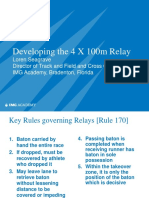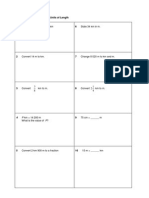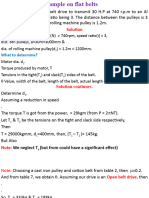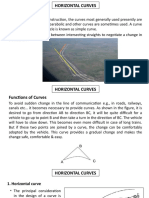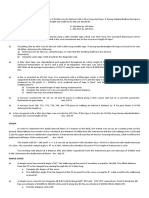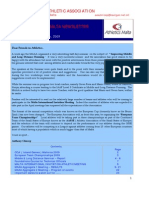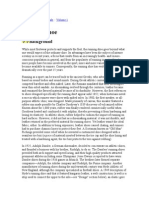Activity 4
Activity 4
Uploaded by
Ng Wan LinCopyright:
Available Formats
Activity 4
Activity 4
Uploaded by
Ng Wan LinOriginal Description:
Copyright
Available Formats
Share this document
Did you find this document useful?
Is this content inappropriate?
Copyright:
Available Formats
Activity 4
Activity 4
Uploaded by
Ng Wan LinCopyright:
Available Formats
The design of tracks shown in Diagram 1 is the track that is usually used in the tracks
tournament. There are another two designs of tracks which has a measurement of 400m in
Lane 1 and width of the line is the same.
Question 1:
Using your own creativity, create two designs of tracks which has a measurement of 400 m
in Lane 1 and width of each lane is the same.
Solutions:
TRACK DESIGN 1 :
The track fulfils the following specifications:
o The running distance from the inner edge of the inner lane is 300mm.
o There are 8 lanes.
o Each lane is 1.22m wide.
o The track is consists of two straight sections joined by two semi-circular sections.
Lane 1
On the curved section has a radius of 36.5m,
but we need to add 300 mm for the "running position",
for a total of 36.8 m.
The radius is 36.8 m
So the Circumference = 2 radius = 2
36.8 m = 231.221 m
Add the 2 straight section of 84.39m:
231.221m + 2 84.39 m = 231.221m + 168.78m = 400 m
Lane 2
Each lane is 1.22m wide, the radius for Lane 2 will be 36.8m + 1.22m = 38.02 m
The radius of lane 2 is 38.02 m
So the Circumference = 2 38.02 m = 238.887 m
Add the two straight section of 84.39 m:
238.887 m + 2 84.39 m = 238.887 m + 168.78 m = 407.65 m
That is 7.65 m longer than Lane 1.
So, Lane 2 should start 7.65 m after Lane 1 to be fair.
Lane 3
Each lane is 1.22m wide, the radius for Lane 3 will be 38.02m + 1.22m = 39.24 m
The radius of lane 3 is 39.24 m
So the Circumference = 2 39.24 m = 246.552 m
Add the two straight section of 84.39 m:
246.552 m + 2 84.39 m = 246.552 m+ 168.78 m = 415.332 m
That is 7.65 m longer than Lane 2.
So, Lane 3 should start 7.65 m after Lane 2 to be fair.
Lane 4
Each lane is 1.22m wide, the radius for Lane 4 will be 39.24m + 1.22m = 40.46 m
The radius of lane 4 is 40.46 m
So the Circumference = 2 40.46 m = 254.218 m
Add the two straight section of 84.39 m:
254.218 m + 2 84.39 m = 254.218 m+ 168.78 m = 422.998 m
That is 7.65 m longer than Lane 3.
So, Lane 4 should start 7.65 m after Lane 3 to be fair.
Lane 5
Each lane is 1.22m wide, the radius for Lane 5 will be 40.46m + 1.22m = 41.68 m
The radius of lane 5 is 41.68 m
So the Circumference = 2 41.68 m = 261.883m
Add the two straight section of 84.39 m:
261.883 m + 2 84.39 m = 261.883 m+ 168.78 m = 430.663 m
That is 7.65 m longer than Lane 4.
So, Lane 5 should start 7.65 m after Lane 4 to be fair.
Lane 6
Each lane is 1.22m wide, the radius for Lane 6 will be 41.68m + 1.22m = 42.90 m
The radius of lane 6 is 42.90 m
So the Circumference = 2 42.90 m = 269.549m
Add the two straight section of 84.39 m:
269.549m+ 2 84.39 m = 269.549 m+ 168.78 m = 438.329 m
That is 7.65 m longer than Lane 5.
So, Lane 6 should start 7.65 m after Lane 5 to be fair.
Lane 7
Each lane is 1.22m wide, the radius for Lane 7 will be 42.90m + 1.22m = 44.12 m
The radius of lane 7 is 44.12 m
So the Circumference = 2 44.12 m = 277.214m
Add the two straight section of 84.39 m:
277.214m+ 2 84.39 m = 277.214 m+ 168.78 m = 445.994 m
That is 7.65 m longer than Lane 6.
So, Lane 7 should start 7.65 m after Lane 6 to be fair.
Lane 8
Each lane is 1.22m wide, the radius for Lane 8 will be 44.12m+ 1.22m = 45.34 m
The radius of lane 8 is 45.34 m
So the Circumference = 2 45.34 m = 284.880m
Add the two straight section of 84.39 m:
284.880m+ 2 84.39 m = 284.880 m+ 168.78 m = 453.660 m
That is 7.65 m longer than Lane 7.
So, Lane 8 should start 7.65 m after Lane 7 to be fair.
Design 1
Presentation of data:
Lane Radius(m) Circumference(m)
Total
distance(m)
Staggered Start(m)
1 36.80 231.221 400.00 0.00
2 38.02 238.887 407.667 7.67
3 39.24 246.552 415.332 7.67
4 40.46 254.218 422.998 7.67
5 41.68 261.883 430.663 7.67
6 42.90 269.549 438.329 7.67
7 44.12 277.214 445.994 7.67
8 45.34 284.880 453.660 7.67
Track Design 2:
The track fulfils the following specifications:
o The distance around the inside edge of the inner lane is 300mm.
o There are 8 lanes.
o Each lane is 1.20m wide.
o The track is consists of two straight sections joined by two semi-circular sections.
o Each of the straight sections is curve for the 120m race, as shown below).
Lane 1
[Using =3.142]
On the curved section has a radius of 25.461m
The radius is 25.461 m
So the Circumference = 2 radius = 2 25.461 = 160m
Add the 2 straight section of 120m: 160m + 2 120 m = 160m+ 240m= 400m
Lane 2
Since each lane is 1.20m wide, so the radius for Lane 2 will be
25.461+ 1.2 = 26.661m
The radius of lane 2 is 26.661m
So the Circumference = 2 26.661 m = 167.538 m
Add the two straight section of 120m:
167.538m + 2 120 m = 167.538m + 240 m = 407.538 m
That is 7.538m longer than Lane 1.
So, Lane 2 should start 7.541 m after Lane 1 to be fair.
Presentation of data:
Lane Radius(m) Circumference(m)
Total
distance(m)
Staggered
Start(m)
1 25.461 160.000 400.000 0.00 m
2 26.661 167.538 407.538 7.538
3 27.861 175.079 415.079 7.541
4 29.061 182.619 422.619 7.541
5 30.261 190.160 430.160 7.541
6 31.461 197.701 437.701 7.541
7 32.661 205.242 445.242 7.541
8 33.861 212.783 452.783 7.541
The radius of the curved section is 73.2484/2= 36.6242.You get
this answer by taking away 85 twice from 400M so the answer is
230M. 230M is the circumference of the two semicircles and so
working out the radius of the two circles, you do 230M divided by
=3.14 and so you get the diameter of 73.2484M. The radius is
half of that and so the radius is 36.6242M
LENGTH OF
INSIDE EDGE
AVERAGE LENGTH
OF INSIDE LANE
RADIUS STAGGER
DISTANCE IN A
400 M RACE
400 403.925 36.6242 0 DISTANCE
FROM STARTING LINE
407.85 411.775 37.8742 7.85M FROM
STARTING LINE
415.70 419.625 39.1242 15.7M FROM
STARTING LINE
423.55 427.475 40.3742 23.55M FROM
STARTING LINE
431.40 435.325 41.6242 31.4M FROM
STARTING LINE
439.25 443.175 42.8742 39.25M FROM
STARTING LINE
447.10 451.025 44.1242 47.1M FROM
STARTING LINE
454.95 458.875 45.3742 54.95M FROM
STARTING LINE
462.8 466.725 46.6242 62.8M FROM
STARTING LINE
Radius of the curved sections:
As the straight sections of the track are both 85m long, 170m of the track is
straight. That means that the remaining 230m of the track is comprised of
the two semicircular sections. As there are two semicircular sections, each of
equal radii, the sum of their inside edges (of the inside lanes) is equal to the
circumference of a circle that would fit neatly into the inside curves of the
track.
The circumference of a circle, c, is given by the equation: c=2 r,
where r is the radius.
Therefore, as we have deduced that the circumference of this imaginary circle
is equal to the sum of the inside curves of the track, we can
write: 230=2 r, so r=2302 =36.606 metres (to 3 d.p.)
This measurement is only the measurement of the radii of the semicircles
which comprise the inside edge of the inside lane on the curved section. We
want to find a measurement for the radii of the semicircles which comprise
the whole of both curved sections; there are 8 lanes that we must consider in
order to do this. As each lane is a constant 1.25 metres, the sum of the
thickness of the lanes is equal to 8 x 1.25 = 10 metres. Therefore, the radius
of the curved sections, in order to produce a scale drawing, is equal to:
36.606 + 10 = 46.606 metres (to 3 d.p.)
The 200m Staggered Start:
As it is mentioned in the problem for the 400m start that the measurement
for the length of a given lane is that of its inside edge, I will assume that it is
the inside edges of each lane that must be made constant in the 200m race in
order to make the race fair. The runner in lane 1 starts at the curved section
on the bottom right of the track, so I will use that lane for comparison with
the others. The straights do not need to be compensated for in the staggered
start, as the runners would all run the same distance here. Therefore, we only
need to consider the 115m of track that the runners will run on before they
hit the straight; in this time, all runners will be running on the curved section
of track.
The runner in lane 2 is running on a track with an inside edge that is 1.25m
further outwards than that of lane 1. Therefore, the radius of runner 2's track
is equal to 36.606+1.25=37.856 metres. Thus, the circumference of the
semicircle that makes up the curved section is equal
to: 2 r2 = r=118.927 metres This is 3.927 metres longer than the inside
edge of lane 1, so the rune in lane 2 will start 3.927 metres in front of the
runner in lane 1.
We can also generate an nth term sequence for the lanes. The nth term for
this sequence is: (36.606+1.25(n1)) I arrived at this conclusion because
the formula for the arc of a semicircle is pi x r, hence the reason for
multiplying the sequence by pi, and the section in brackets is the way to
determine the radius of the inside edge of any given track. Each runner, as
we move from lane 1 to lane 8, will start 3.927 metres (3 d.p.) in front of the
previous runner.
The 400m Staggered Start:
The obvious conclusion for this problem would be to say that each runner
starts twice as far behind the runner in the next inside lane as they did in the
200m race, but I will investigate this mathematically.
Each runner is running 400 metres, but 170 metres of the track they will run
(85 x 2) is made up of straight sections, where the runners will run the same
distance regardless of the lane they are in, so this does not need to be
compensated for. Thus, 230m of the track they will run on is comprised of a
curved section, which must be compensated for. When the runner in lane 2
reaches a curved section, the radius of the inner edge of his/her lane is equal
to 36.606+1.25=37.856 metres. Thus, the arc lengths of both semicircles
together is equal to: 2 37.856=237.854 metres (3 d.p.) This is 7.854
metres longer than the length of curved track in lane 1, so the runner in lane
2 will start 7.854 metres in front of the runner in lane 2.
We can also generate an nth term sequence for the lanes. The nth term for
this sequence is: 2 ((36.606+1.25(n1)) pi). I arrived at this conclusion
using the nth term formula I generated before to calculate the arc length of
one of the semicircular pieces of track, then multiplied it by 2 (for the two
semicircles involved in the 400m. As we move from lane 1 to lane 8, each
runner starts 7.854 metres in front of the runner on the next inside lane to
them.
Question 2:
Based on your track designed in question (a) and Diagram 1, which design would you choose
for your school tournament?
State your justification.
Based on the track designed in question (a) and Diagram 1, I will choose field track question
(a) of design 1 in for my school tournament.
This is because an outdoor track measures 400 meters (m) around, with standard
measurements of 84.39m for the straights and 115.611m for the curves.
These distances are typically measured either 20 centimetres (cm) from the inside of
the track (if no rail or curb exists on the inside), or 30cm from the inside (if there is a
rail or curb in place). One straightaway is extended for the start and finish of sprint
races.
This track will have eight lanes. Six and nine lane tracks are also common, while two
and four lane tracks are occasionally made. A tenth lane becomes too wide and gives
too much advantage to the outside athlete in the 200m, since running a turn is less
efficient than running a straight. Tracks used for international competition will
always be either eight or nine lanes.
Each lane is 1.22m wide.
A common finish line exists for all running events. Consequently, there are many
starting lines on a track.
Runners experience centrifugal force which slows their progress.
Circular tracks have a constant curvature, and so runners get
no relief from this force.
Curvature is greatest in lane 1 which puts that runner at a
disadvantage.
The javelin event is held in the middle of the track. The
longest throws are 100 m, which rules out circular and
long/thin tracks for safety reasons.
When running around curved sections:
A straight stretch is required for events
There are a number of reasons:
Why dont they simply make running tracks circular?
Total distance of the running track
= total distance of lane + distance of running track border + distance
of finishing line + distance of starting line
2 (100) + 2r
A) FINDING TOTAL DISTANCE
Total distance of lane
The distance of the 8 lane (obtained from Activity 1) are added
400.000 + 407.542 + 415.082 + 422.624 + 428.908 + 437.708 + 445.246 + 452.786
=3409.896m
Distance of running track border
The distance of the running track border is same as the distance of the 9
th
lane
Thus, using = 3.142, the formula below is used:
To find radius, r, formula used:
Where, a= 31.827,
d = 1.2
T
9
= 31.827 + (9 1) (1.2)
= 41.427m
Therefore, the distance of the running track border
Tn = a + (n-1)d
=2 (100) + 2 (3.142) (41.427)
= 460.327m
Distance of finishing line
Since there are 8 lanes with 1.2m wide each, the distance of finishing line is:
8 x 1.2m = 9.6m
Distance of starting line
Although there are 8 starting line, there is 1 line overlap with the finishing line. So, we
assume that there are only 7 starting line.
Since the width of each lane is 1.2m, the total distance of starting line is:
7 x 1.2m = 8.4m
--------------------------------------------
Therefore, the total distance of running track
= 3409.896m + 460.327m + 9.6m + 8.4m
= 38888.223
You might also like
- All Games Ground MarkingDocument94 pagesAll Games Ground MarkingAmmar Khokhar88% (58)
- Grade 6 Aural GuideDocument6 pagesGrade 6 Aural GuideJamielcm100% (2)
- IAAF Track and Field Facilities Manual 2008 Edition - Marking Plan 400m Standard Track PDFDocument1 pageIAAF Track and Field Facilities Manual 2008 Edition - Marking Plan 400m Standard Track PDFShui Meei100% (4)
- Surveying Note Curve Ranging Chapter 6Document9 pagesSurveying Note Curve Ranging Chapter 6Michael Noi0% (2)
- A Progressive Shuttle Run TestDocument5 pagesA Progressive Shuttle Run TestLing Lii LikNo ratings yet
- Staggered 200mDocument2 pagesStaggered 200mpyanz110750% (2)
- Elementary Surveying Lecture Part 1Document7 pagesElementary Surveying Lecture Part 1soontobengineer100% (1)
- Microsoft Office 365 Keys HereDocument16 pagesMicrosoft Office 365 Keys HereNg Wan Lin30% (20)
- Sprint Training - Compressed PDFDocument4 pagesSprint Training - Compressed PDFJoão Sério100% (4)
- Rajan BhatiaDocument16 pagesRajan BhatiaVinod RanaNo ratings yet
- Utkarsh Track MarkingDocument16 pagesUtkarsh Track MarkingDinesh ChoudharyNo ratings yet
- 300m Running TrackDocument2 pages300m Running TrackMohaza LuccaNo ratings yet
- Warm Up Sebleum LariDocument12 pagesWarm Up Sebleum Lariamian4484No ratings yet
- Jadual Periodisasi Latihan EditedDocument3 pagesJadual Periodisasi Latihan EditedEVENo ratings yet
- Latihan Mingguan Lompat JauhDocument2 pagesLatihan Mingguan Lompat JauhmanrunnerNo ratings yet
- Latihan Mingguan Lompat JauhDocument2 pagesLatihan Mingguan Lompat JauhDewiMuhd89100% (1)
- Asas Kawad KakiDocument13 pagesAsas Kawad KakiNur Syahirah0% (1)
- Long JumpDocument20 pagesLong JumpDavid AdohNo ratings yet
- Contoh 1: Jadual Latihan Harian (Fasa Persediaan Umum)Document6 pagesContoh 1: Jadual Latihan Harian (Fasa Persediaan Umum)Irfan DanialNo ratings yet
- Lesson Plan Sprints RelaysDocument4 pagesLesson Plan Sprints Relaysapi-313645927No ratings yet
- Jadual Latihan Pusat (Labang)Document1 pageJadual Latihan Pusat (Labang)Jayjay DayangNo ratings yet
- Walker Coaching-The-Long-JumpDocument29 pagesWalker Coaching-The-Long-Jumpapi-313469173No ratings yet
- Lab 2 Isaac Justine D20191089836Document5 pagesLab 2 Isaac Justine D20191089836Joko MrNo ratings yet
- Jadual Latihan Atlet Lontar Peluru SK San SemanjuDocument3 pagesJadual Latihan Atlet Lontar Peluru SK San SemanjuRonoroa ZoroNo ratings yet
- Workout Training For Long JumpDocument6 pagesWorkout Training For Long JumpAmir Aiman AkashahNo ratings yet
- UKA Athletics Coach Induction Pack v2 Jan 2013Document36 pagesUKA Athletics Coach Induction Pack v2 Jan 2013gpitbullNo ratings yet
- Developing 4 X 100 RelayDocument26 pagesDeveloping 4 X 100 Relayapi-391225671100% (1)
- Iaaf 400 Metre Standard Track, Marking Plan: SCALE - 1:350Document1 pageIaaf 400 Metre Standard Track, Marking Plan: SCALE - 1:350hossam100% (1)
- Penulis Karya Agung Tokoh Nilam Peringkat Negeri WP Labuan 2020Document2 pagesPenulis Karya Agung Tokoh Nilam Peringkat Negeri WP Labuan 2020misteriNo ratings yet
- Jadual Latihan TenisDocument1 pageJadual Latihan TenisLuqman Hakeem100% (1)
- Marking A 400m Grass Track-Pdf21042015Document19 pagesMarking A 400m Grass Track-Pdf21042015BabaNo ratings yet
- Rulebook Final 1Document56 pagesRulebook Final 1Ravi Berwal100% (1)
- Jadual Latihan Memanah (Seminggu) : Masa Ahad Isnin Selasa Rabu Khamis Jumaat SabtuDocument3 pagesJadual Latihan Memanah (Seminggu) : Masa Ahad Isnin Selasa Rabu Khamis Jumaat SabtuHasnan Shazali MeorNo ratings yet
- Netball ModuleDocument12 pagesNetball ModuleChegu MoralNo ratings yet
- Approach Strategies in The Long Jump - James HayDocument16 pagesApproach Strategies in The Long Jump - James HayAnonymous sYX58BrtcNo ratings yet
- Contoh Balapan 200 MeterDocument18 pagesContoh Balapan 200 Meterzeman9199No ratings yet
- Construction of 400m TrackDocument62 pagesConstruction of 400m Trackmurnirah8478% (23)
- Activity 2: Data Analysis: A) Two Suitable Problem Solving StrategiesDocument6 pagesActivity 2: Data Analysis: A) Two Suitable Problem Solving StrategiesNg Wan LinNo ratings yet
- Higher Eng Maths 9th Ed 2021 Solutions ChapterDocument19 pagesHigher Eng Maths 9th Ed 2021 Solutions ChapterAubrey JosephNo ratings yet
- SurveyingDocument6 pagesSurveyingMARK KEVIN GUTIERREZNo ratings yet
- Marking An Athletics Track and Field EventsDocument10 pagesMarking An Athletics Track and Field EventsMatt WhyteNo ratings yet
- Track MarkingDocument6 pagesTrack MarkingSports Psychology DepartmentNo ratings yet
- Plane Trigonometry: OA Be The Initial Side OB Be The Terminal SideDocument14 pagesPlane Trigonometry: OA Be The Initial Side OB Be The Terminal SideJo HarNo ratings yet
- Chapter - 8 MotionDocument17 pagesChapter - 8 MotionShreyans JainNo ratings yet
- Geometric CurvesDocument2 pagesGeometric CurvesMary Faith LopezNo ratings yet
- Surveying ReviewerDocument7 pagesSurveying ReviewerJin Eve AveNo ratings yet
- JJ309 Fluid Mechanics Unit 6Document30 pagesJJ309 Fluid Mechanics Unit 6Adib Azhar100% (1)
- The CircleDocument9 pagesThe CircleavislgNo ratings yet
- Y5 Topic 7 - Length PDFDocument19 pagesY5 Topic 7 - Length PDFSheela SheeluNo ratings yet
- Lecture 8.1 Examples On Belts-1Document15 pagesLecture 8.1 Examples On Belts-1Omo GabNo ratings yet
- GH-311 Circular MeasureDocument7 pagesGH-311 Circular MeasurezaedmohdNo ratings yet
- Games and SportsDocument97 pagesGames and SportsAnand Deep Roy100% (1)
- Lesson 11 Simple CurvesDocument18 pagesLesson 11 Simple CurvesMANGABAT, KAREN JOY C.No ratings yet
- B Tech I Year - Previous Year Questions Engineering Drawing Unit - IDocument4 pagesB Tech I Year - Previous Year Questions Engineering Drawing Unit - ISavantNo ratings yet
- CH 11Document21 pagesCH 11Anil DhariwalNo ratings yet
- Final Take HomeDocument5 pagesFinal Take HomeFuchi del CachorroNo ratings yet
- Laws of MotionDocument12 pagesLaws of Motionptv7105No ratings yet
- UEBE1843 Topic 2.1Document42 pagesUEBE1843 Topic 2.1Bdsm JapaneseNo ratings yet
- SURVEYING I and IIDocument10 pagesSURVEYING I and IIBer Ryl0% (1)
- Extra Widening of Road On Horizontal CurvesDocument16 pagesExtra Widening of Road On Horizontal CurvesKim Junmyeon50% (2)
- Prelim Exam of Route Surveying QuestionnaireDocument1 pagePrelim Exam of Route Surveying QuestionnaireAnniesonNo ratings yet
- Chapter 12 Circles AnswersDocument8 pagesChapter 12 Circles AnswersSandeep BhargavaNo ratings yet
- Grade 7 Mensuration Perimeter Area Volume AnswersDocument12 pagesGrade 7 Mensuration Perimeter Area Volume AnswersJamal BhattiNo ratings yet
- PAPER 3 BiologyDocument11 pagesPAPER 3 BiologyNg Wan LinNo ratings yet
- SPM Trigonometry F5Document11 pagesSPM Trigonometry F5cajaroNo ratings yet
- Tips For SPM Bahasa Melayu and English 1119Document32 pagesTips For SPM Bahasa Melayu and English 1119Ng Wan LinNo ratings yet
- Additional Mathematics Project Work SPM 1/ 2014: Jabatan Pelajaran Pulau PinangDocument5 pagesAdditional Mathematics Project Work SPM 1/ 2014: Jabatan Pelajaran Pulau PinangNg Wan LinNo ratings yet
- Answering Technique Physics Paper-3Document10 pagesAnswering Technique Physics Paper-3Ng Wan LinNo ratings yet
- Essays For SPM and Muet StudentsDocument38 pagesEssays For SPM and Muet StudentsNg Wan Lin75% (4)
- Activity 3: Data Interpretation: A) Finding Total DistanceDocument3 pagesActivity 3: Data Interpretation: A) Finding Total DistanceNg Wan LinNo ratings yet
- Tips For SPM Bahasa Melayu and English 1119Document32 pagesTips For SPM Bahasa Melayu and English 1119Ng Wan LinNo ratings yet
- Activity 2: Data Analysis: A) Two Suitable Problem Solving StrategiesDocument6 pagesActivity 2: Data Analysis: A) Two Suitable Problem Solving StrategiesNg Wan LinNo ratings yet
- Conjecture and ConclusionDocument1 pageConjecture and ConclusionNg Wan LinNo ratings yet
- ContentDocument1 pageContentNg Wan LinNo ratings yet
- Activity 1: Collecting Information: A) Finding Radius B) Finding Circumference of SemicircleDocument5 pagesActivity 1: Collecting Information: A) Finding Radius B) Finding Circumference of SemicircleNg Wan LinNo ratings yet
- (297998865) Track DesignDocument1 page(297998865) Track DesignNg Wan LinNo ratings yet
- Materials: Alka-Seltzer Tablet (Pharmacy)Document1 pageMaterials: Alka-Seltzer Tablet (Pharmacy)Ng Wan LinNo ratings yet
- Track Design: © University of CambridgeDocument1 pageTrack Design: © University of CambridgeNg Wan LinNo ratings yet
- SportDocument12 pagesSportChelle Tambo AbosNo ratings yet
- Athletic CVDocument3 pagesAthletic CVapi-315758547No ratings yet
- Heroes of Running June 2013Document3 pagesHeroes of Running June 2013Anom AnomNo ratings yet
- Reflective EssayDocument4 pagesReflective EssayjordanboehningNo ratings yet
- 800 and 1600 Meter Training and Racing - CompressedDocument23 pages800 and 1600 Meter Training and Racing - Compressedaman dhillon100% (1)
- Summary SoftballDocument4 pagesSummary SoftballChristian Paul MacatangayNo ratings yet
- Teaching Athletics Skills, Part 2Document67 pagesTeaching Athletics Skills, Part 2Anonymous GJuRvp9A5TNo ratings yet
- Q&A With Clyde Hart: Coach To Michael Johnson & Jeremey WarinerDocument16 pagesQ&A With Clyde Hart: Coach To Michael Johnson & Jeremey WarinertaylorNo ratings yet
- DNA - Seido Pitchers DataDocument12 pagesDNA - Seido Pitchers DatamaciiishuuNo ratings yet
- Physical Education Investigatory Project On AthleticsDocument30 pagesPhysical Education Investigatory Project On AthleticsAbhimanyu60% (5)
- 2014 Bank of America Chicago Marathon Media GuideDocument135 pages2014 Bank of America Chicago Marathon Media GuideAlberto StrettiNo ratings yet
- Reading SectionDocument11 pagesReading SectionSigit PrasetyoNo ratings yet
- Newsletter No - 29Document23 pagesNewsletter No - 29pawluNo ratings yet
- Rules For Track Events: (Based On IAAF Official Handbook)Document35 pagesRules For Track Events: (Based On IAAF Official Handbook)Ajay Pal NattNo ratings yet
- Speed Workouts For Track and FieldDocument3 pagesSpeed Workouts For Track and FieldGreg LaBelleNo ratings yet
- Nearly 100 The Woodlands Marathon Finishers Qualify For The 2016 Boston MarathonDocument4 pagesNearly 100 The Woodlands Marathon Finishers Qualify For The 2016 Boston MarathonJon WalkNo ratings yet
- Track Field AthleticsDocument9 pagesTrack Field Athleticskenneth100% (1)
- IAAF EntriesDocument32 pagesIAAF EntriesBrianne DyerNo ratings yet
- Sports Feature SampleDocument3 pagesSports Feature SampleJENNIFER LUMBRES100% (1)
- Race 13.1 Training 5k - Intermediate: Remember: You Can & You Will!Document3 pagesRace 13.1 Training 5k - Intermediate: Remember: You Can & You Will!Darren NolanNo ratings yet
- Fabián Roncero: International CompetitionsDocument2 pagesFabián Roncero: International CompetitionsjulioguatemalaNo ratings yet
- 1988 OSU Track & Field Media GuideDocument59 pages1988 OSU Track & Field Media Guidetravis_floeckNo ratings yet
- Interview: When Did You Start Athletics?Document6 pagesInterview: When Did You Start Athletics?Cherbiti Mohammed AmineNo ratings yet
- Running ShoesDocument7 pagesRunning ShoesShanmugarajChandrahasanNo ratings yet
- Assignmnt AthltcsDocument7 pagesAssignmnt AthltcsJaleel HalepotoNo ratings yet
- IT'S NOT THAT HARD!!! How To Run A 100km Trail UltramarathonDocument1 pageIT'S NOT THAT HARD!!! How To Run A 100km Trail UltramarathonDominic CaddenNo ratings yet
- IAAFDocument4 pagesIAAFEra ShahNo ratings yet
- Athle DiapoDocument3 pagesAthle DiapoJean Christophe DangladesNo ratings yet
- 2011 Runners GuideDocument21 pages2011 Runners GuidezilusiliozaeNo ratings yet


























